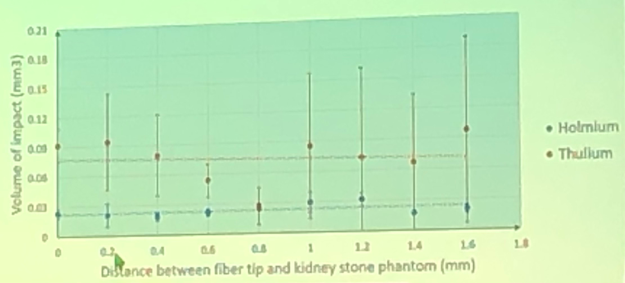They utilized a 50W TFL and 30W Ho:YAG laser (Figure 1). In preparation for their study, the group modified their two lasers so that they could deliver a single pulse to their artificial stone phantom, the Begostone. The placed both 272 micron laser fibers perpendicular to the target at different set distances for a total of ten trials. The group also treated both hard and soft stone phantoms in an in vitro model using a disposable ureteroscope with 200 micron lasers. They treated these stones for two minutes and the stones were dried and weighed both before and after treatment.

After having delivered the single pulses to the Begostones, they then analyzed the resulting craters created by the laser pulses and measured them by microscopy. Across all distances, the TFL made higher volumes of impact compared to the Ho:YAG laser. (Figure 2) The volume ablated was about three times higher with the TFL. Average destruction speeds for fine dusting, dusting, and fragmentation were 0.57, 1.32, and 1.99 mg/sec respectively for TFL. For Ho:YAG, for dusting and fragmentation, the average destruction speeds were 0.25 and 0.8 mg/sec respectively.

This is an interesting study coming out of Paris. Although there was no significant difference between the depth of impact between the two lasers, the surface area of the crater created by the thulium laser was larger thus revealing the three times higher volume of ablation. Moreover, the TFL fragmented twice as fast and dusted 5 times as fast as the Ho:YAG laser. These may be attributed to the higher frequencies that the TFL can reach. Although high frequencies can be a cause for potential concern, the group also presented earlier during this same conference that there is no difference in temperature between TFL and Ho:YAG. That is, “Watts” seems to be the primary influencer of temperature and as long as lower energy is balanced with higher frequency, temperatures can be taken under control. There will definitely be further in vivo studies that are necessary to confirm all of these observations. Just as the Ho:YAG laser became extensively studied, the same rite of passage will be required of this thulium fiber technology.
Presented by: Steeve Doizi, MD. Assistant Professor of Endourology, PETRA
Written by: John Sung (@JohnM_Sung), Medical Student Texas A&M University, College of Medicine, Dallas, Texas, Research Fellow, University of California, Irvine Department of Urology at the American Urological Association's 2019 Annual Meeting (AUA 2019), May 3 – 6, 2019 in Chicago, Illinois


